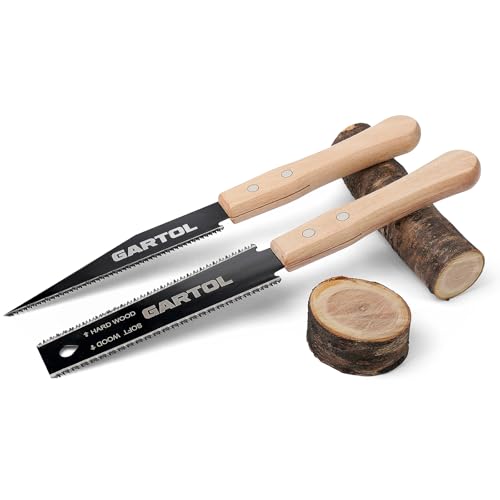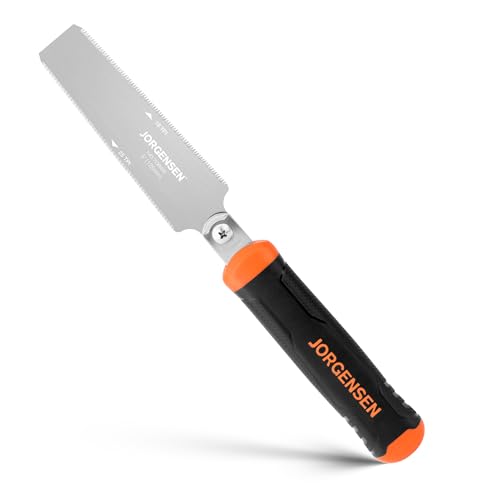When it comes to woodworking, few tools are as admired as Japanese saws. But what makes them so special? Let’s break it down.
Japanese woodworking saws are designed to cut on the pull stroke, giving woodworkers more precision with less effort. This unique design allows for thinner blades, cleaner cuts, and greater control compared to traditional Western saws. If you’re exploring the best Japanese saws, you’ll quickly see why so many craftsmen rely on them.
But here’s the catch—choosing the right saw isn’t always easy. From Dozuki to Ryoba and Kataba, each style serves a different purpose. And if you’ve ever looked into the best mitre saws or other cutting tools, you’ll know how important it is to pick the right one for the job.
So, what’s the bottom line? If you’re serious about finding the best saws for woodworking, Japanese pull saws deserve your attention.
Top Picks
Best Dual-Cutting: SUIZAN Ryoba Double Edge Saw 9.5" Assembly ver
The SUIZAN Ryoba Double Edge Saw is a Japanese pull saw that cuts on the pull stroke, offering more control and cleaner results than traditional push saws. It is crafted from premium Japanese steel for razor-sharp performance and durability. With a dual-edge blade for both rip and crosscut tasks, it provides flexibility in woodworking projects. The blade measures 9.5 inches with fine teeth for detailed work and coarse teeth for faster cuts. Each handle is hand-wrapped, making every piece unique.
Users often highlight the sharpness and efficiency of the blade, noting that it requires less effort compared to Western saws. Many appreciate the precision it brings to both detailed and general woodworking tasks. Some customers point out that the assembly step may not appeal to beginners, and minor handle imperfections can occur due to the handmade process. Experts recognize it as a reliable tool that delivers professional-quality cuts across a variety of wood types.
The SUIZAN Ryoba Double Edge Saw stands out for its cutting performance, traditional craftsmanship, and versatility. Despite minor drawbacks in assembly and handle uniformity, it offers excellent value for both hobbyists and professional woodworkers seeking precision and efficiency in their work.
Best Compact Saw: SUIZAN Ryoba Double Edge Saw 6" - Professional Japanese Pullsaw
The SUIZAN Ryoba Double Edge Saw 6-inch model is a compact Japanese pull saw designed for precision. Unlike push saws, it cuts on the pull stroke, allowing smoother control and a cleaner edge. Built with high-quality Japanese steel, it delivers razor-sharp performance across hardwoods like oak and maple as well as softwoods such as cedar and pine. The dual-edge blade combines rip and crosscut functions, offering flexibility for different woodworking needs. With a blade thickness of 0.4 millimeters and fine teeth, it ensures accurate cuts with minimal effort.
Woodworkers often praise its sharpness and portability, especially for small projects and detailed cuts where larger saws feel cumbersome. The balance and lightweight design make it accessible for beginners while still reliable for experienced craftsmen. Some users note that the smaller blade size limits its use on larger pieces, making it more of a specialty tool rather than an all-purpose option. Experts highlight its precise cutting ability and versatility for both hardwood and softwood applications.
The SUIZAN Ryoba Double Edge Saw 6-inch offers excellent precision, portability, and cutting quality for fine woodworking tasks. While it may not replace a full-size saw for bigger projects, its performance and craftsmanship make it a valuable tool for detail-oriented work and compact cutting situations.
Best Flush Cutting: Co. Japanese Flush Cut Saw - 6 Inch Double Edge Pull Saw for Flush Cutting Dowels
The Co. Japanese Flush Cut Saw is a 6-inch double-edge pull saw designed specifically for trimming dowels, pegs, wedges, and tenons flush to adjacent surfaces. It features a slim, narrow-kerf blade that cuts on the pull stroke, allowing smooth, accurate results with minimal effort. The blade is forged from durable Japanese steel, ensuring long-lasting sharpness and precision on both hardwoods and softwoods. Its beechwood handle with brass accents offers both durability and a refined appearance, balancing performance with aesthetic appeal.
Woodworkers value this saw for its ability to create seamless flush finishes, making it a go-to tool for joinery work and fine detailing. Many highlight its ease of use, lightweight build, and consistent sharpness. The premium handle design is also noted as comfortable and visually appealing. However, some recognize that it is not meant for heavy-duty or deep cuts, making it more of a specialty tool. Experts praise its craftsmanship, noting the combination of Japanese steel and Western-inspired design elements as a thoughtful balance of tradition and innovation.
The Co. Japanese Flush Cut Saw delivers excellent performance for precision flush trimming tasks, standing out for its craftsmanship, cutting quality, and elegant design. While limited in scope compared to larger saws, it offers significant value for woodworkers who prioritize clean, professional finishes in detailed joinery work.
FAQs
What are the best Japanese woodworking tools?
The best Japanese woodworking tools typically include saws, chisels, and planes. Japanese saws are highly regarded for their sharpness and ability to make clean cuts, while chisels are crafted from layered steel for both strength and precision. Hand planes, known as kanna, are also popular for finishing wood surfaces. Together, these tools form the foundation of traditional Japanese woodworking, offering both efficiency and artistry.
Are Japanese saws any good?
Yes, Japanese saws are considered excellent by both professional and hobbyist woodworkers. Their design focuses on cutting with the pull stroke, which reduces blade deflection and gives greater accuracy. The thin, razor-sharp blades allow for precise joinery and smooth finishes, making them particularly valuable in fine woodworking. While they require a learning curve compared to Western push saws, the results are well worth it.
What is Dozuki vs Ryoba vs Kataba?
Dozuki, Ryoba, and Kataba are the three main types of Japanese saws. A Dozuki is a backsaw with a rigid spine, perfect for detailed joinery and dovetail work. The Ryoba has two cutting edges—one for ripping along the grain and one for crosscutting—making it versatile for different tasks. The Kataba, on the other hand, is a single-edged saw without a back, ideal for deeper cuts where a Dozuki’s spine might get in the way. Each type serves a unique role in woodworking.
What is a Japanese wood saw?
A Japanese wood saw is a traditional hand tool designed to cut on the pull stroke rather than the push stroke used by Western saws. This method allows for thinner blades, sharper teeth, and less physical effort during cutting. Japanese wood saws are widely used in cabinetry, furniture making, and fine joinery, where precision and smooth finishes are essential.
What is the best Japanese saw brand?
Some of the best Japanese saw brands include Gyokucho, Suizan, and Silky. Gyokucho is particularly well-known for producing reliable, high-quality saws that cater to both beginners and professionals. Suizan is praised for its handcrafted tools, combining traditional design with modern production techniques. Silky, while more commonly recognized for pruning saws, also offers woodworking options. These brands are highly recommended for their sharpness, durability, and ease of use.
Conclusion
Japanese woodworking saws stand out for their precision, sharpness, and versatility. Whether you’re looking for a Dozuki for joinery, a Ryoba for versatility, or a Kataba for deep cuts, these tools bring a level of craftsmanship that is hard to match. By choosing a reputable brand and understanding which saw fits your project, you can elevate your woodworking skills with tools trusted by craftsmen for generations.






















